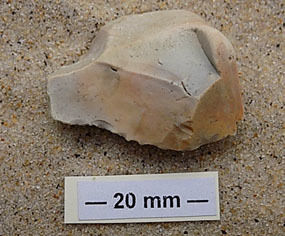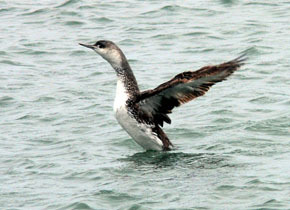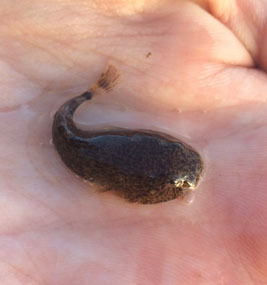Hudson River Almanac 11/11/17 - 11/17/17
The New York State Department of Environmental Conservation sent this bulletin on 11/24/2017 02:00 PM EST |
| DEC Delivers - Information to keep you connected and informed from the NYS Department of Environmental Conservation |
| Share or view as a web page || Update preferences or unsubscribe |
|
|
|
Our first snowy owl of the season was spotted this week. Otherwise the autumn raptor migration was tapering off with a late run of golden eagles and red-shouldered hawks. Water temperature and salinity in the estuary were dropping as the seasons changed. HIGHLIGHT OF THE WEEK 11/15 – Ulster County, HRM 93: Very early this morning Jim Clinton spotted a snowy owl (Bubo scandiacus) in the Town of Ulster. Several birders searched throughout the day with no luck in relocating the bird. Amazingly, this is at least the fourth snowy owl to be seen in that general area in the last 20 years. [While snowy owl incursions are typically “dead of winter” events, they can show up anytime from late fall through early spring. Their presence often signals difficult hunting in the Arctic (hares and lemmings) and they frequently arrive here starving. Due to their “fluffy feathered look,” they often seem quite healthy, even while in the throes of starvation. Over the last three winters, the Almanac has documented 24 snowy owls in the watershed, a number likely far fewer than all those that were present. NATURAL HISTORY NOTES 11/11 – Rensselaer County, HRM 162: Continuing our annual tradition of circumnavigating Tomhannock Reservoir every Veterans’ Day, we found 51 species – bettering our totals from the last three years and exceeding the ten-year average by one. Waterfowl highlights included wood duck, gadwall, green-winged teal, ring-necked duck, a single common loon, pie-billed grebe, and a distant flock of 19 long-tailed ducks that had us perplexed for a time. Other notables included two immature bald eagles and tree swallows (25 or so despite the sub-freezing air temperature). The cumulative list from 17 years stands at exactly 100 species. 11/11 – Bedford, HRM 35: We spotted an immature golden eagle migrating west in mid-afternoon at the Chestnut Ridge Hawkwatch. A modest flight of red-shouldered hawks passed, a dozen in close succession. It had been a while since we spotted a merlin but we had one today. Non-raptor observations included a single yellow-bellied sapsucker.
11/11 – Croton-Harmon, HRM 34.5: After a night of 20 degrees Fahrenheit and 20 miles-per-hour northwest winds (windchill near zero), today’s temperature peaked at 25 degrees. With an almost instant onset of winter, I saw two first-of-season birds: an American tree sparrow and several buffleheads. [See banner photo of buffleheads courtesy of Edward Mertz.] 11/11 – Hook Mountain, HRM 31: We spotted no migrating raptors today at the Hook Mountain Hawkwatch. Our entire count consisted of turkey vultures (6). Non-raptor observations included snow buntings. 11/11 – Manhattan, HRM 5: The air temperature fell to 24 degrees F today, tying the record low for the date. 11/11 – Manhattan, HRM 1: Our research collection gear (killifish traps) in Hudson River Park at The River Project's sampling station on the lighthouse tender Lilac at Pier 25 held two small butterfish 20 and 40 millimeters [mm] long. While those were highlights, we also found an oyster toadfish (200 mm) and a very handsome black sea bass (215 mm). 11/12 – Beacon, HR 61: The rapidly falling water temperature (55 degrees F, down six degrees in a week) and salinity (from 1.5 to less than one part-per-thousand [ppt]) limited our expectations as we set our seine in the low tide shallows. Those expectations were met as every haul came up empty. But then on our last haul, much to our surprise, we had fish, six of them, all tessellated darters (64-66 mm). These were the first darters we had caught in this reach of the river since early May. 11/12 – Bedford, HRM 35: On an otherwise calm day at the Chestnut Ridge Hawkwatch, we spotted a migrating immature northern goshawk, a season’s first. Red-tailed hawks (19) were high count for raptors. Non-raptor observations included three male common mergansers. 11/12 – Nyack, HR 28: The air temperature fell to 25 degrees F today, tying the record low for the date. 11/13 – Esopus Meadows, HRM 87: The red-throated loon that has been around for nearly two weeks now has “buddies.” Two long-tailed ducks have been in the river off Esopus Meadows for a couple of days and appear to drift with the tide. Tonight, while the tide was going out, they floated south for a while before flying back upriver to feed in the shallows off the Esopus Meadows Lighthouse. In the background were a few buffleheads and a raft of black ducks 11/13 – Hook Mountain, HRM 31: A rainy morning contributed to very few migrants today at the Hook Mountain Hawkwatch. Our count included an immature bald eagle (185 for the season) and a red-tailed hawk. There were no non-raptor observations.
11/14 – Town of Poughkeepsie: As I watched this morning, I spotted the female of bald eagle nest NY62 perched in the nest tree. Within minutes the male flew in with sticks, landed in the nest, and began fitting them into the latticework of the sides. Soon, the female hopped down into the nest and began helping with stick placement. Having accomplished that task, both exited out the back door of the nest and flew north. What a great way to start my day! 11/14 – Bedford, HRM 35: We had a calm day at the Chestnut Ridge Hawkwatch with some excitement in the last hour – an immature golden eagle (ten for the season) and a merlin heading west. Non-raptor observations included a flock of common grackles (250). 11/14 – Hook Mountain, HRM 31: In mid-morning at the Hook Mountain Hawkwatch, an adult female Cooper's hawk flew east from Nyack Ridge past the south dropoff of Hook Mountain and vanished over Hook's east cliff. Ten minutes later the same hawk popped up over Hook's west tree line, proceeded east and vanished. Three ravens were spotted dogfighting with an adult red -tailed hawk; later two more ravens flew southwest with one in threatening pursuit of the other. The only non-raptor observation was a group of 17 turkey vultures “kettling” out beyond Tallman Mountain. However, constant scanning to stay warm produced not a single migrant raptor in four hours. 11/15 – Hudson River Watershed: The season has arrived when we should give some serious thought to our wildlife viewing and photographing habits. Cold weather can be especially challenging for birds. They run on a strict energy budget balancing calories-in with calories-out, instinctively prioritizing conservation of energy. Every time we flush a winter bird by trying to get closer, or employ audio lures to draw them in, the calories needed for them to move depletes their reservoir. If they are near evening roost time, they might need to replenish in order to keep their furnaces stoked all night. “Getting closer” should be much more a function of our optics than our legs. [In 24 years of the Hudson River Almanac, we have recorded 14 species of gulls in the watershed, along the tidewater Hudson, the Mohawk River, and adjacent uplands: 11/15 – Bedford, HRM 35: A small push of Cooper's hawks (six) came through in mid-morning at the Chestnut Ridge Hawkwatch. An immature golden eagle (now 11 for the season) came through later (an immature golden eagle spotted at Quaker Ridge may have been the same bird). Red-shouldered hawks (10) were high count among raptors. Non-raptor observations included several dozen crows on the move.
[The skilletfish (Gobiesox strumosus) is a small benthos-loving fish somewhat related to gobies and blennies. They find oyster reefs ideal habitat for both forage and safety. Their name comes from a dorsally-flattened body with a large, roundish head that altogether look like a skillet. The skilletfish was added to the Hudson River Checklist of Fishes in April of 2012. That 52 mm skilletfish was caught from an artificial oyster reef by The River Project. Tom Lake.] 11/16 – Saratoga County, HRM 157: I walked west along the towpath at Vischer Ferry Preserve this afternoon and found a more diverse collection of ducks than on our field trip here four days ago. The ice in the ponds had melted. While there were no diving ducks present, I did find dabblers, among them wood ducks, American wigeon, American black ducks, green-winged teal, northern shovelers, and northern pintails. I also counted six eastern bluebirds. [The Mohawk Towpath Byway runs from Waterford to Schenectady along the historic route of the Eire Canal. The road tells the story of the Erie Canal and the role our local communities played in the westward expansion of the country and in the Industrial Revolution. Diverse wildlife habitats, classic architecture, and beautiful vistas are sprinkled throughout the corridor. The word “towpath” comes from a period of Erie Canal's history when canal vessels were moved principally by draft animals–mostly mules–that pulled from the path atop the side berm of the canal along the Mohawk River. New York State Department of Transportation.] 11/16 – Beacon, HRM 61: The salinity barely measured 1.0 ppt, down from a high of 5.0 in early October (salinity greatly influences what fish species are potentially present). It is never a waste of time to sample the river; every result, ranging from “nothing” (research axiom: no data is still data) to a net bulging with life contributes to our understanding. We considered these comforting “truths” when we landed our seine to find just three fish. It was as though the local populations had designated one each of their number to show up: spottail shiner, white perch, and tessellated darter. The water temperature was 53 degrees F. 11/16 – Bedford, HRM 35: It was very quiet today at the Chestnut Ridge Hawkwatch with kettles of turkey vultures (68) slowly moving about on the foggy horizon. Some fireworks began in mid-afternoon when two immature golden eagles moved northwest. Golden eagles (13 on the season) have been coming through in mid-afternoon in five of the last seven days. There were no non-raptor observations. 11/17 – Hudson River watershed: Would you like to experience the excitement and camaraderie of the Christmas Bird Count? The 116th New York State Christmas Bird Count (CBC), a National Audubon citizen science project, is scheduled for December 14, 2017 through January 5, 2018. Count areas are circles 15 miles in diameter. Within each circle, a team of volunteers spends an entire day counting all bird species and the number of individuals within each species. The results are compiled at the end of the day for each circle, and then sent to National Audubon. If you’d like to participate, find a count in your area and contact the coordinator; check out the New York State Ornithological Association’s online CBC calendar. [The Christmas Bird Count, the nation’s longest running citizen-science effort, is held throughout the country at year’s end. It replaced the Victorian era “side-shoot,” in which guests chose up sides and then went out to shoot as many different bird and other animal species as they could on Christmas Day. In 1900, ornithologist Frank Chapman organized a group of friends to observe, count and share information about bird species without shooting them. The National Audubon Society, which Chapman helped organize, now sponsors this annual tradition. As an enlightened alternative, thousands of people go out to count and publish as many bird species as their group can in a sporting, competitive manor. The result has been the gathering of data regarding changes in bird populations and range over the years, including indications that the center of abundance for many has moved 200 miles north over the last forty years. Rich Guthrie.] 11/17 – Bedford, HRM 35: Turkey vultures (55) were high count today at the Chestnut Ridge Hawkwatch. Red-shouldered hawks (seven) were high among raptors. We also had one male northern harrier. There were no non-raptor observations of note. HUDSON RIVER MILES The Hudson is measured north from Hudson River Mile 0 at the Battery at the southern tip of Manhattan. The George Washington Bridge is at HRM 12, the Tappan Zee 28, Bear Mountain 47, Beacon-Newburgh 62, Mid-Hudson 75, Kingston-Rhinecliff 95, Rip Van Winkle 114, and the Federal Dam at Troy, the head of tidewater, at 153. The tidal section of the Hudson constitutes a bit less than half the total distance – 315 miles – from Lake Tear of the Clouds to the Battery. Entries from points east and west in the watershed reference the corresponding river mile on the mainstem. TO CONTRIBUTE YOUR OBSERVATIONS OR TO SUBSCRIBE The Hudson River Almanac is compiled and edited by Tom Lake and emailed weekly by DEC's Hudson River Estuary Program. Share your observations by e-mailing them to trlake7@aol.com. To subscribe to the Almanac (or to unsubscribe), use the links on DEC's Hudson River Almanac or DEC Delivers web pages. Discover New York State Conservationist - the award-winning, advertisement-free magazine focusing on New York State's great outdoors and natural resources. Conservationist features stunning photography, informative articles and around-the-state coverage. Visit the Conservationist webpage for more information. USEFUL LINKS National Oceanic and Atmospheric Administration online tide and tidal current predictions are invaluable when planning Hudson River field trips. For real-time information on Hudson River tides, weather and water conditions from twelve monitoring stations, visit the Hudson River Environmental Conditions Observing System website. Information about the Hudson River Estuary Program is available on DEC's website at http://www.dec.ny.gov/lands/4920.html . Smartphone app available for New York outdoor enthusiasts! Copies of past issues of the Hudson River Almanac, Volumes II-VIII, are available for purchase from the publisher, Purple Mountain Press, (800) 325-2665, or email purple@catskill.net |


 11/11 – Westchester County, HRM 35-34: The “endless summer” had ended. Until yesterday we had enjoyed warm weather and “summer nature.” Now it felt like winter. During the past week I had spotted orange sulphur and monarch butterflies, found ten species of mushrooms including the deadly destroying angel and the edible shaggy mane, and enjoyed many flowers including red clover, dandelion, aster, butter-and-eggs, and Queen Anne’s lace. The long summer into autumn was much enjoyed. [Photo of shaggy mane mushroom courtesy of Edward Mertz.]
11/11 – Westchester County, HRM 35-34: The “endless summer” had ended. Until yesterday we had enjoyed warm weather and “summer nature.” Now it felt like winter. During the past week I had spotted orange sulphur and monarch butterflies, found ten species of mushrooms including the deadly destroying angel and the edible shaggy mane, and enjoyed many flowers including red clover, dandelion, aster, butter-and-eggs, and Queen Anne’s lace. The long summer into autumn was much enjoyed. [Photo of shaggy mane mushroom courtesy of Edward Mertz.] As we collected the darters to measure, we found a small (32 mm) stone knife in the sand. It caught our eye because the stone looked as though it had been “worked” (modified by human hands). We were not the first people on this beach! It had been fashioned out of a type of creamy-white chert called chalcedony; its serrated and burnished edge may have been used to skin a squirrel or process a perch. Being a universal tool, it could have been 500 years old or 5,000 years old, and it had eroded out of the sand from the deep past. [Photo of stone knife courtesy of Tom Lake.]
As we collected the darters to measure, we found a small (32 mm) stone knife in the sand. It caught our eye because the stone looked as though it had been “worked” (modified by human hands). We were not the first people on this beach! It had been fashioned out of a type of creamy-white chert called chalcedony; its serrated and burnished edge may have been used to skin a squirrel or process a perch. Being a universal tool, it could have been 500 years old or 5,000 years old, and it had eroded out of the sand from the deep past. [Photo of stone knife courtesy of Tom Lake.] 11/14 – Saratoga County, HRM 182: In mid-morning, two red-throated loons were visible at the northern end of Saratoga Lake. One was seen from Saratoga Springs Waterfront Park and the other from the New York State boat launch at Saratoga Lake Marine Park on Route 9P. [Photo of immature red-throated loon by Lee Karney courtesy U.S. Fish and Wildlife Service.]
11/14 – Saratoga County, HRM 182: In mid-morning, two red-throated loons were visible at the northern end of Saratoga Lake. One was seen from Saratoga Springs Waterfront Park and the other from the New York State boat launch at Saratoga Lake Marine Park on Route 9P. [Photo of immature red-throated loon by Lee Karney courtesy U.S. Fish and Wildlife Service.] 11/15 – Manhattan, HRM 1: When we went to check our research collection gear in Hudson River Park at The River Project's sampling station on the lighthouse tender Lilac at Pier 25 we were greeted by two gorgeous tautog (195, 225 mm) and a white perch (180 mm). A killifish trap had also caught a skilletfish (70 mm). [Photo of young skilletfish courtesy of Melissa Rex.]
11/15 – Manhattan, HRM 1: When we went to check our research collection gear in Hudson River Park at The River Project's sampling station on the lighthouse tender Lilac at Pier 25 we were greeted by two gorgeous tautog (195, 225 mm) and a white perch (180 mm). A killifish trap had also caught a skilletfish (70 mm). [Photo of young skilletfish courtesy of Melissa Rex.]